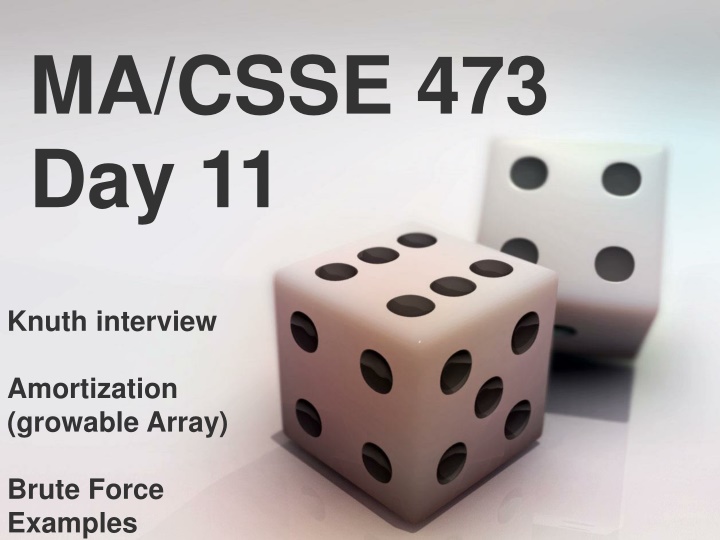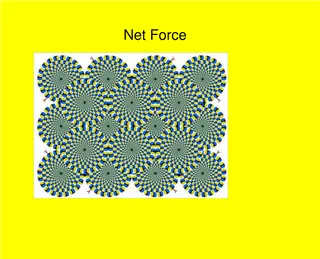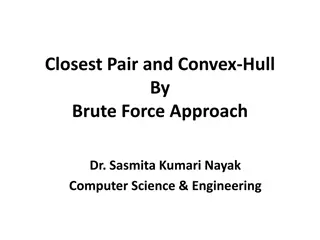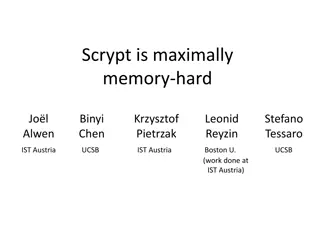Knuth Interview: Amortization with Growable Array and Brute Force Examples
This content delves into an interview with Knuth on amortization, showcasing implementations involving growable arrays and examples of brute force techniques. Dive into the exploration of this intriguing topic to enhance your understanding of these concepts.
Download Presentation

Please find below an Image/Link to download the presentation.
The content on the website is provided AS IS for your information and personal use only. It may not be sold, licensed, or shared on other websites without obtaining consent from the author.If you encounter any issues during the download, it is possible that the publisher has removed the file from their server.
You are allowed to download the files provided on this website for personal or commercial use, subject to the condition that they are used lawfully. All files are the property of their respective owners.
The content on the website is provided AS IS for your information and personal use only. It may not be sold, licensed, or shared on other websites without obtaining consent from the author.
E N D
Presentation Transcript
MA/CSSE 473 Day 11 Knuth interview Amortization (growable Array) Brute Force Examples
MA/CSSE 473 Day 11 Questions? Donald Knuth Interview Amortization Brute force (if time) Decrease and conquer intro Q1-2
Donald Knuth Interview List a few things that you found interesting in the interview What questions would you ask Donald Knuth if you had the chance?
Amortized efficiency analysis P49-50 in the textbook We analyze not just a single operation, but a sequence of operations performed on the same structure We conclude something about the worst-case of the average of all of the operations in the sequence Example: Growable array exercise from 220/230, which we will quickly review today
Growable Array (implement ArrayList) An ArrayList has a size and a capacity The capacity is the length of the fixed-size array currently allocated to hold the list elements For definiteness, we start with size=0 and capacity=12 We add a total of N items (N is not known in advance), one at a time, each to the end of the structure When there is no room in the array (i.e. capacity=size and we need to add another element) Allocate a new, larger array copy the size existing elements to the new array add the new element to the new array
Growable Array (implement ArrayList) When there is no room in the array (i.e. capacity=size and we need to add another element) Allocate a new, larger array copy the size existing elements to the new array add the new element to the new array What is the total/average overhead (due to element copying) if a. we add one to the array capacity each time we have to grow it? b. we double the array capacity each time we have to grow it? Note in the second case that the amortized worst-case cost is asymptotically less than the worst case for a single element Every time we have to enlarge the capacity, we make it so we do not have to enlarge again soon.
Brute Force Algorithms Straightforward, simple, not subtle, usually a simple application of the problem definition. Often not very efficient Easy to implement, so often the best choice if you know you'll only apply it to small input sizes 3-4
What is a brute force approach to Calculate the nth Fibonacci number? Compute the nth power of an integer? Search for a particular value in a sorted array? Sort an array? Search for a substring of a string? Find the maximum contiguous subsequence in an array of integers? Find the largest element in a Binary Search Tree? Find the two closest points among N points in the plane? Find the convex hull of a set of points in the plane? 10. Find the shortest path from vertex A to vertex B in a weighted graph? 11. Solve the traveling salesman problem? 12. Solve the knapsack problem? 13. Solve the assignment problem? 14. Solve the n n non-attacking chess queens problem? 15. Other problems that you can think of? 1. 2. 3. 4. 5. 6. 7. 8. 9.
Decrease and Conquer Algorithms What does the term mean? Reduce problem instance to smaller instance of the same problem Solve smaller instance Extend solution of smaller instance to obtain solution to original instance Also referred to as inductive or incremental approach Can be implemented either top-down or bottom-up Three variations. Decrease by constant amount constant factor variable amount
One Problem, Four approaches Recall the problem of integer exponentiation: Compute an, where n is a power of 2: Brute Force: an= a*a*a*a*...*a Divide and conquer: an= an/2 * an/2 Decrease by one: an= an-1* a Decrease by constant factor: an= (an/2)2
Variable Decrease Examples Euclid's algorithm b and a % b are smaller than a and b, but not by a constant amount or constant factor Interpolation search The two sides of the partitioning element are smaller than n, but can be anything from 0 to n-1.
Interpolation Search Searches a sorted array similar to binary search but estimates location of the search key in A[l..r] by using its value v. Specifically, the values of the array s elements are assumed to increase linearly from A[l] to A[r] Location of v is estimated as the x-coordinate of the point on the straight line through (l, A[l]) and (r, A[r]) whose y-coordinate is v: x = l + (v - A[l])(r - l)/(A[r] A[l] )
Interpolation Search Running time Average case: (log (log n)) Worst: (n) What can lead to worst-case behavior? Social Security numbers of US residents Phone book (Wilkes-Barre) CSSE department employees, 1984-2014 Red and blue are current employees
Some "decrease by one" algorithms Insertion sort Selection Sort Depth-first search of a graph Breadth-first search of a graph
Review: Analysis of Insertion Sort Time efficiency Cworst(n) = n(n-1)/2 (n2) Cavg(n) n2/4 (n2) Cbest(n) = n - 1 (n) (also fast on almost-sorted arrays) Space efficiency: in-place (constant extra storage) Stable: yes Binary insertion sort use Binary search, then move elements to make room for inserted element
Graph Traversal Many problems require processing all graph vertices (and edges) in systematic fashion Most common Graph traversal algorithms: Depth-first search (DFS) Breadth-first search (BFS)
Depth-First Search (DFS) Visits a graph s vertices by always moving from last visited vertex to unvisited one, backtracks if there is no adjacent unvisited vertex is available Uses a stack (or could use recursion) a vertex is pushed onto the stack when it s reached for the first time a vertex is popped off the stack when it becomes a dead end, i.e., when there are no adjacent unvisited vertices Redraws graph in tree-like fashion (with tree edges and back edges for undirected graph) A back edge is an edge of the graph that goes from the current vertex to a previously visited vertex (other than the current vertex's parent in the tree).
Notes on DFS DFS can be implemented with graphs represented as: adjacency matrix: (V2) adjacency list: (|V|+|E|) Yields two distinct ordering of vertices: order in which vertices are first encountered (pushed onto stack) order in which vertices become dead-ends (popped off stack) Applications: checking connectivity, finding connected components checking acyclicity finding articulation points searching state-space of problems for solution (AI)
Example: DFS traversal of undirected graph a b c d e f g h DFS traversal stack: DFS tree:






















